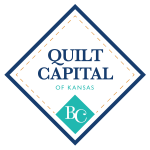Timeless Stitches
Published in The Baldwin City Community News
June 9, 2022

It's not a Quilt Until It's Quilted
--Sharon Vesecky
First off, what is the difference between a quilt and a blanket? A blanket is defined as a large piece of fabric, woolen, or other material, used as a covering, as on a bed. A quilt is defined as a decorative textile such as a bedspread made of three layers of fabric stitched together. The center layer is most commonly batting, a thicker textile that adds warmth and texture. The top may be pieced or otherwise embellished. So, to be a quilt, the layers must be quilted together.

Obviously, hand quilting was around long before quilting machines were even imagined. Joseph’s “Coat of Many Colors” described in the Bible is considered to be a very early example of a quilted garment. For warmth, we may assume that it was more than one layer of cloth and that those layers were held together with hand stitching because no machine had yet been invented to sew those layers together.
The hand quilting process is quite simple. The three layers—quilt top, batting, and backing—are stacked, smoothed out, and some tension is applied to hold them smooth between the side rails of a quilting frame until they can be basted together to stabilize them and then hand quilted. Traditional quilting frames are most often constructed of wood, although more recently some frames have been made with PVC pipe. As the quilting progresses, the quilted portion is unrolled from one side rail and rolled up around the opposite side. This process of working across the quilt in accessible sections is continued until the stitching is complete. Another style of quilting floor frame replaces the side rails with a base similar to a saw horse. Holes drilled into the top of the “saw horse” accept the rounded ends of the top and bottom rails. The quilt is rolled up on the far rail and is rolled onto the close rail as quilting progresses. This style allows the quilter to reach clear across the available quilting area.
Sometimes sturdy hoops are used instead of a quilting frame, so smaller portions of the project are available for stitching at any given time. When a section is completed, the hoop is repositioned and stitching resumes. I prefer to use a hoop for quilting because I can turn it whichever way I want to stitch. It enables me to always work from right to left.
The tools of the trade are very simple—a tiny needle with a tiny eye (that may necessitate using a needle threader), a spool of thread, a thimble, and scissors. The needles most often used for hand quilting are called betweens. They are shorter than other needles and the eye can be difficult to thread. Beginners usually start with a size 8 needle. The needles get smaller as the size numbers get larger. Most accomplished quilters use a size 12.
A thimble of some sort is a must to push the needle through the thicknesses of fabric. Thimbles come in different sizes and shapes to accommodate various sized fingers. They are worn on the middle finger of the dominant hand. Their purpose is not to protect you from sticking yourself, but to PUSH the needle through the fabric layers. Quilters strive to develop a rocking motion that puts several stitches on the needle at a time. The goal is to make very small stitches and to have the quilting enhance the design of the quilt. I have very little patience with quilters who say, “Oh, but my stitches will show!” Of course the stitches are going to show. If not, why quilt the item in the first place?
A small pair of embroidery scissors is adequate for the quilting project. The scissors are used to clip the thread. You will want to use a sturdy thread, either “hand-quilting thread” or a 35 weight cotton thread. The hand-quilting thread has a coating on it that makes it easier to get through the small eye of the needle. To keep the thread from tangling you may want pull your thread through bee’s wax or a synthetic product such as Thread Heaven before stitching.
Quilters who enjoy hand quilting often cite the activity as being restful or soothing. And those quilters experience a huge sense of accomplishment when their quilt is finished!